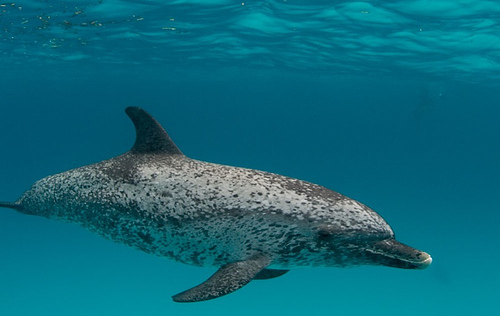Spotted Dolphin

Find A Hotel in Los Cabos
Fantastic deals on hotels in Los Cabos with our booking partners. Amazing discounts on over 100 properties, instant reservation and user reviews/ratings to guarantee you get the hotel you want, when you want it. In many cases you PAY NOTHING now...check it out here!
This sleek, long dolphin has a distinct
coloration: its back is covered in a dark gray patch of skin or "saddle'
that spreads from its front to past the dorsal fin. Small white spots
cover the dark area, and dark spots speckle the creamy white belly. It
also has a dark patch over the eyes and several other distinct dark
lines on the face and body. The dorsal fin is curved and the flukes and
flippers are small and pointed. The size of the spotted dolphin can
vary, but individuals in coastal populations tend to be larger.
These dolphins can gather in groups of 1,000
or more individuals, and these super pods are often seen by fishermen
during tuna season. Spotted dolphin pods include both sexes and all
ages, and sometimes they blend schools with other dolphin species as
well, such as the spinner and long-beaked common dolphins. These agile
dolphins can swim up to 28 km/h and may speed next to the whale-watching
boats, performing acrobatic leaps.
A female Spotted dolphin will have one calf
every 2 to 3 years, after an 11½ -month gestation period; the calf will
rely on her milk for 18 months. These dolphins can live for up to 45
years, but tragically, thousands are killed every year in nets set for
yellow fin tuna. Because the spotted dolphin's diet is similar to this
tuna, the dolphins are often with them, and sometimes fishermen
purposefully follow the dolphins to the tuna-and subsequently pull them
in with the catch. If you want to play your part in preventing this,
please try to buy only tuna marked clearly as “Caught by pole and line”.